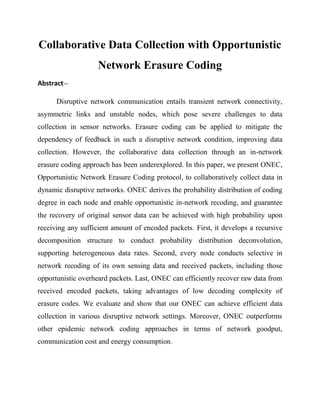
Collaborative data collection with opportunistic
- 1. Collaborative Data Collection with Opportunistic Network Erasure Coding Abstract— Disruptive network communication entails transient network connectivity, asymmetric links and unstable nodes, which pose severe challenges to data collection in sensor networks. Erasure coding can be applied to mitigate the dependency of feedback in such a disruptive network condition, improving data collection. However, the collaborative data collection through an in-network erasure coding approach has been underexplored. In this paper, we present ONEC, Opportunistic Network Erasure Coding protocol, to collaboratively collect data in dynamic disruptive networks. ONEC derives the probability distribution of coding degree in each node and enable opportunistic in-network recoding, and guarantee the recovery of original sensor data can be achieved with high probability upon receiving any sufficient amount of encoded packets. First, it develops a recursive decomposition structure to conduct probability distribution deconvolution, supporting heterogeneous data rates. Second, every node conducts selective in network recoding of its own sensing data and received packets, including those opportunistic overheard packets. Last, ONEC can efficiently recover raw data from received encoded packets, taking advantages of low decoding complexity of erasure codes. We evaluate and show that our ONEC can achieve efficient data collection in various disruptive network settings. Moreover, ONEC outperforms other epidemic network coding approaches in terms of network goodput, communication cost and energy consumption.
- 2. Existing System: The erasure codes were initially proposed to enable reliable broadcast over “one-to-many” communication conditions, where feedback is very expensive or even infeasible, such as satellite broadcast or Internet video broadcast applications. LT (Luby Transform) code [2] is the first effective implementation of erasure codes with low encoding and decoding complexity. Due to its low complexity in both encoding and decoding sides, it is appropriate to be utilized in wireless sensor nodes where the computing capability is limited. However, the redundant coding overhead introduced can compromise its efficiency, if LT code applies without alteration to the network where multiple data sources exist. The core of LT code is the RSD (Robust Soliton Distribution), which is a probability distribution of encoding degree for each packet. The data recovery can be proved as high probability, providing that each degree in encoding packet is independently drawn from RSD, and sufficient amount of packets arrive at decoder, e.g. K+c ・ √ K・ ln2(K δ ), and K is the symbol size. As each node encodes its own k symbols using individual RSD, the overhead for successfully decoding, N ・ c ・ √ k ・ ln2( k δ ), scales with the network size N. In the other hand, if we view all the source symbols as originating from single “super node”, allowing recoding in the forwarding nodes, the message overhead will be significantly reduced to c ・ √ N ・ k ・ ln2(N·k δ ) for large network size N. For example, in Figure 1, every node has different symbol sizes to send, e.g. 50 or 100 respectively, totaling 400 in the network. In the first case shown in the upper graph of Figure 1, individual RSD is applied to generate encoded packets, and no recoding occurs in the forwarding nodes. The total amount 650Moreover, intermediate recoding takes advantage of
- 3. opportunistic overhearing in wireless broadcasting to combat communication loss. Those two reasons motivate the design of ONEC for a collaborative data collection. Proposed System: In this paper, we present the design, implementation, and evaluation of ONEC, an Opportunistic Network Erasure Coding protocol for reliable data delivery over disruptive sensor networks. ONEC is designed to transform the “end to-end” paradigm of LT codes to “manyto- one” network LT codes. Firstly, it adopts recursive decomposition structure to conduct probability distribution deconvolution, supporting heterogeneous symbol sizes in each source nodes. Secondly, it allows every node to carry out selective recoding from its own sensing data and received packets. Thirdly, it enables opportunistic recoding on the overheard packets, based on relay hop distance. It can compensate the information deficit due to lossy transceiving between neighbor nodes. Lastly, ONEC make packet degree distribution closely approximate the RSD, which enables high probability decoding with low computation complexity. The preliminary work is published in [3], and we provide comprehensive design and theoretic analysis details in this articleLow coding overhead: ONEC utilizes the intermediate recoding to reduce the redundant encoding overhead. The recursive deconvolution only takes place during network initialization and the time when network dynamics happen. The control message cost for relaying decomposed degree distribution message is minimized. • Disruption tolerance: By enabling opportunistic encoding in the intermediate nodes on the forwarding paths, ONEC becomes resilient to disruptive networks. Opportunistic overhearing of symbols are incorporated
- 4. into the encoded packets to make the upstream nodes sustainable in presence of some failure in downstream nodes. • Low latency and buffer space: In ONEC, the intermediate nodes recode packets but not decode them. Hence, little buffer space is required to store and conduct XOR on received encoded packets. • Performance with low coding complexity: Extensive performance analysis reveals the advantages of ONEC over existing methods, in terms of network goodput, message complexity and buffer space. The rest of the paper is organized as follows. In section 2, we summarize the related works. Then we presents the designs of ONEC protocol in section 3. In the following section 4, we report our simulation results in different network configurations.